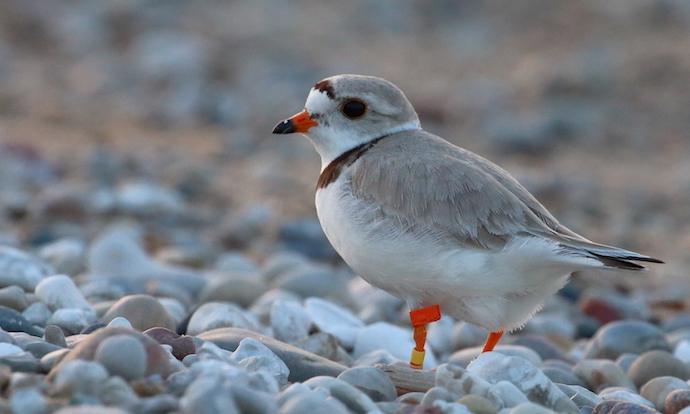
First Piping Plover Returns To Sleeping Bear Dunes
By Emily Tyra | April 16, 2020
Sign of spring: the first piping plover — an endangered shorebird — has returned to its nesting beach within the Sleeping Bear Dunes National Lakeshore.
Plovers winter on the southern Atlantic Coast and Gulf Coast but travel to a specific “home” beach during the breeding season and remain through the summer to nest and raise their young. There are only between 70 and 80 nesting pairs in the entire Great Lakes region. About 30 of those pairs come to nest in the Sleeping Bear Dunes.
Sleeping Bear Dunes has an active plover monitoring and protection program in conjunction with the US Fish and Wildlife Service, Michigan DNR, the University of Minnesota, and the University of Michigan Biological Station. Once a nest is found, staff builds an enclosure around the nest site that prevents predators such as dogs, gulls, crows, and raccoons from taking the eggs, while allowing the plovers to pass easily in and out. In addition, because plover eggs and small chicks are very well camouflaged, the areas around the nests are fenced off during the breeding season to protect the birds from disturbance which might cause the birds to abandon their nests, as well as protecting them from being stepped on accidentally.
The Leelanau Ticker talked with Vince Cavalieri, Wildlife Biologist at Sleeping Bear Dunes National Lakeshore, about this rare beach bird’s arrival.
Leelanau Ticker: So, they're back?
Cavalieri: The first sighting was confirmed last Friday. We know the birds that nest at the park because they are banded. We’re always excited to see the first one back, and this bird was the same one that returned first last year, "Of,Yb:X,G," which is our shorthand for the different bands he has on his legs. For many years before that the first to return was a plover we called Old Man Plover, who lived to be 15.
Leelanau Ticker: How far do they travel?
Cavalieri: They come all the way from the Yucatan and the Bahamas, but mostly from South Carolina, Georgia and Florida.
Leelanau Ticker: What makes 30 of the total 80 Great Lakes pairs come specifically to Sleeping Bear?
Cavalieri: It has the best available habitat: a sand dune ecosystem with the biggest and widest beaches — high water notwithstanding. They also have site fidelity…they will come back not only to the same beach, but to the same spot on the beach.
Leelanau Ticker: The males arrive first. What are they up to?
Cavalieri: Establishing their territory with flight displays, calling displays, territory battles with other males. They do this thing we call the 'parallel walk,' where they mirror each other, walking in parallel lines. After divvying up the land, the males dig out the nests. Females arrive one to three weeks later to reunite with the same bird…although we have found that to be tied more to the spot on the beach, not with the mate.
Leelanau Ticker: What should people do if they see a plover on the beach?
Cavalieri: They should keep their distance, obey all signage instructions and keep dogs on leashes. If beach visitors notice plovers showing signs of stress (broken wing displays, calling or flying away), then increase the distance between themselves and the plover.
Leelanau Ticker: There are quite a few piping plover fans out there, yes?
Cavalieri: Yes, they are kind of a cute bird. And they live in beautiful beach areas. And they are very rare.
Leelanau Ticker: Why is that?
Cavalieri: Mostly because of their habitat choice. People really love beaches, too, and want to use the same habitat. It’s a conflict between human and plover.
Leelanau Ticker: How are the plovers dealing with high water on the Great Lakes?
Cavalieri: It is having an effect. We are seeing more problems with nests washing out. They are nesting higher up, in the dunes themselves, and they are crowding up — with nests within 50 meters of each other, it means more fighting and stress on the birds.
Leelanau Ticker: What happens if plovers abandon the nest?
Cavalieri: We typically have a captive rearing program where the chicks go up to the [University of Michigan] Bio Station in Pellston to be reared. The Detroit Zoo sends staff to help. Not entirely sure if it is happening this year because of Covid-19, or what this season will bring.
Editor’s Note: Despite current trail closures, as of April 14, Sleeping Bear Dunes beaches ARE open except for the seasonal closures around the plovers. According to Scott Tucker, Superintendent with the Sleeping Bear Dunes National Lakeshore, “With 71,000 acres and 64 miles of beach, there is a lot that remains open. Behavior on the beaches should be consistent with CDC guidance for social distancing and the Governor’s Stay Home order for single family groups.”
Photo: Vince Cavalieri, Wildlife Biologist at Sleeping Bear Dunes National Lakeshore
CommentNational Study: Leelanau County Tops the Nation in Food Costs
Leelanau County is the most expensive county in the country for food costs, according to a recent ...
Read More >>Tuesday Filing Deadline Brings County Election Races Into Focus
Though early signs indicated a concerningly sparse field for this year’s impending Leelanau County Board of Commissioners ...
Read More >>The Latest Leelanau County Blotter & 911 Call Report
The Leelanau Ticker is back with a look at the most alarming, offbeat, or otherwise newsworthy calls ...
Read More >>Barge Owner Pleads Guilty, Gets One Year To Move Vessel
Donald Balcom, the owner of a decrepit barge that has been repeatedly abandoned at numerous points around ...
Read More >>



